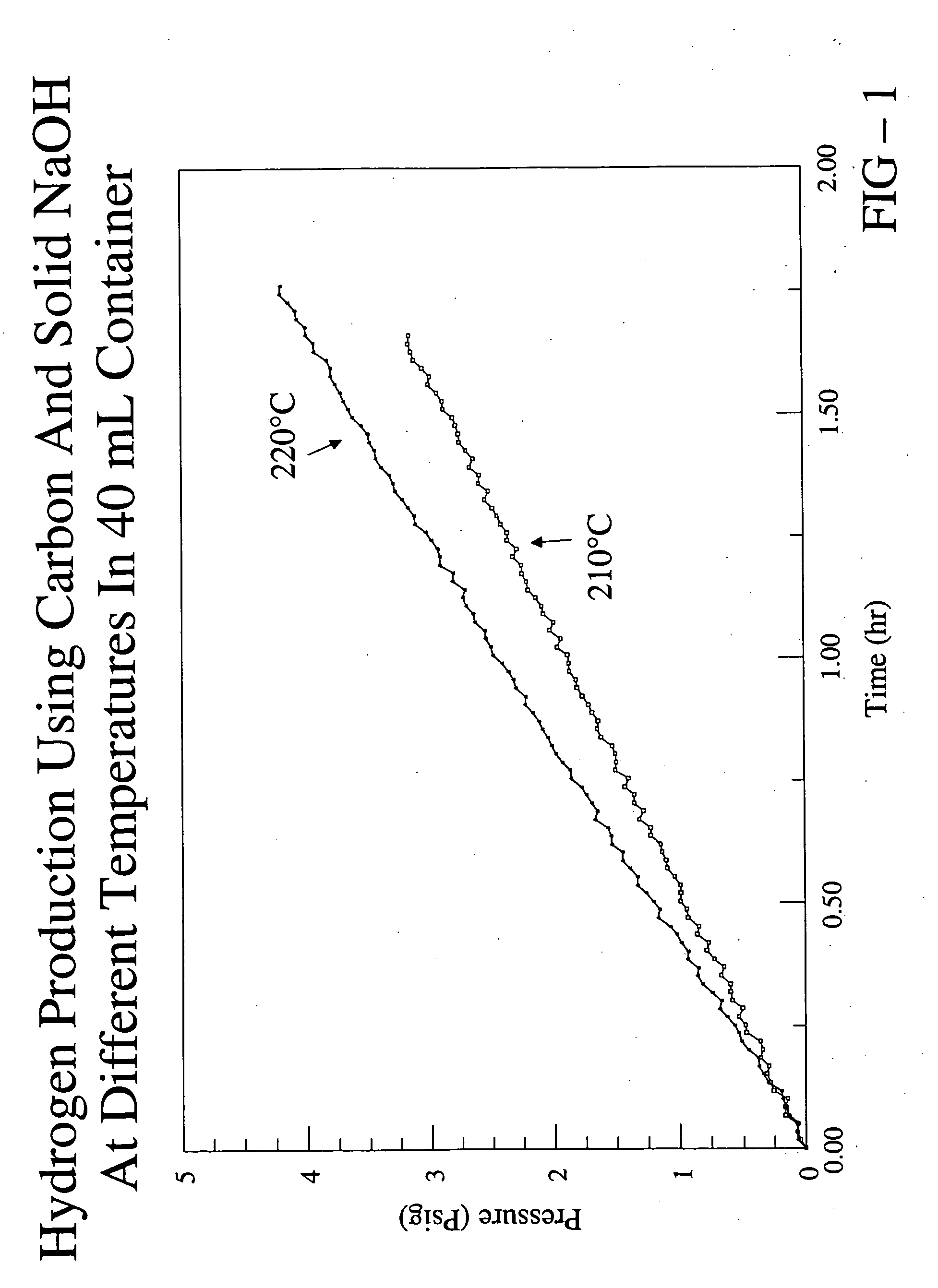Base-facilitated production of hydrogen from carbonaceous matter
a technology of carbonaceous matter and hydrogen gas, which is applied in the field of hydrogen gas production from carbonaceous matter, can solve the problems of increasing fossil fuel consumption, escalating costs, and destabilizing economies as well as the likelihood, so as to improve the thermodynamic spontaneity of production and accelerate the
- Summary
- Abstract
- Description
- Claims
- Application Information
AI Technical Summary
Benefits of technology
Problems solved by technology
Method used
Image
Examples
example 1
[0038] In this example, the production of hydrogen from carbon is described. 0.3 g of carbon black and 2.0 g of solid sodium hydroxide were intimately mixed and placed into a stainless steel cylinder reactor having a volume of ˜40 mL. The sodium hydroxide included about 5% by weight of water. The carbon black and sodium hydroxide occupied about 25% of the volume of the reactor. Electrical coils were wrapped around the reactor for heating and the temperature was controlled with a thermocouple attached to the bottom of the reactor. The reactor was sealed and then flushed with helium to remove oxygen from the reactor. In the flushing process, the cylinder was first evacuated with a vacuum pump and then charged with flowing helium until the pressure reached about atmospheric pressure. The process was performed three times.
[0039] At the end of the third charge with helium, the helium was left in the reactor and the pressure at room temperature was measured to be about 17 psi. The reacto...
example 2
[0042] In this example, the production of hydrogen from coal is described. The coal sample used in this experiment was received from Basic Services, a coal company with a location in Virginia. The sample was excavated out of a part of the raven coal bed located in St. Paul, Va. (Wise County). A chemical analysis of the specific sample used in this experiment was not obtained, but the USGS database mentioned hereinabove provides the following information for three samples extracted from the raven coal bed located in St. Paul, Va.:
TABLE 2Ultimate Analysis of Selected Samples of Coal extractedfrom the Raven Coal Bed (Wt. %)SampleRankLocationHCNOSC / HW203384BituminousVirginia5.1073.701.408.000.9014.45W215446BituminousVirginia4.8472.051.526.501.1014.89W193664BituminousVirginia4.7070.901.406.801.2015.09
[0043] 1.0 g of the coal sample and 7.0 g of solid sodium hydroxide were intimately mixed and placed into a stainless steel cylinder reactor having a volume of ˜40 mL. The sodium hydroxide...
PUM
| Property | Measurement | Unit |
|---|---|---|
| weight percent | aaaaa | aaaaa |
| weight percent | aaaaa | aaaaa |
| weight percent | aaaaa | aaaaa |
Abstract
Description
Claims
Application Information
 Login to View More
Login to View More - R&D
- Intellectual Property
- Life Sciences
- Materials
- Tech Scout
- Unparalleled Data Quality
- Higher Quality Content
- 60% Fewer Hallucinations
Browse by: Latest US Patents, China's latest patents, Technical Efficacy Thesaurus, Application Domain, Technology Topic, Popular Technical Reports.
© 2025 PatSnap. All rights reserved.Legal|Privacy policy|Modern Slavery Act Transparency Statement|Sitemap|About US| Contact US: help@patsnap.com


